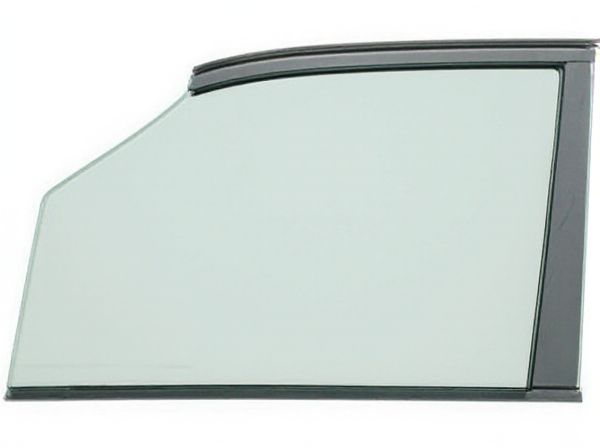
Photo illustration: Curved vs Flat Automotive Glass
Curved automotive glass enhances aerodynamics and aesthetics by conforming to the vehicle's sleek design, providing better wind resistance and reducing noise. Flat glass, often used in older or less expensive models, is simpler to manufacture and replace but may offer less clarity and increased wind drag. Your choice between curved and flat automotive glass influences both vehicle performance and visual appeal.
Table of Comparison
| Feature | Curved Automotive Glass | Flat Automotive Glass |
|---|---|---|
| Design | Aerodynamic, enhances vehicle aesthetics | Simple, traditional design |
| Visibility | Reduces glare and distortion | Standard visibility, possible reflections |
| Manufacturing Complexity | Higher complexity, costly molding | Lower complexity, easier production |
| Strength & Safety | Better impact resistance due to shape | Standard safety, more prone to breakage |
| Cost | More expensive due to shaping and materials | More affordable, widely used |
| Common Use | Luxury and sports vehicles | Economy and standard cars |
Introduction to Automotive Glass Types
Automotive glass primarily includes curved and flat types, each designed to enhance vehicle safety and aesthetics. Curved glass, commonly used for windshields and side windows, improves aerodynamics and visibility by conforming to the vehicle's body shape. Flat glass is typically found in rear windows and sunroofs due to its structural simplicity and ease of manufacturing.
What is Curved Automotive Glass?
Curved automotive glass is specially engineered to match the aerodynamic contours of modern vehicles, enhancing both aesthetic appeal and structural integrity. It undergoes precise bending processes during manufacturing to achieve smooth, curved shapes that improve driver visibility and reduce wind noise. This type of glass also contributes to improved safety by better distributing impact forces in collisions compared to flat glass.
What is Flat Automotive Glass?
Flat automotive glass is a type of vehicle glazing characterized by its flat, planar surface, commonly used in side windows and rear windows of cars. Manufactured through float glass processes and often tempered for safety, flat glass provides clear visibility and structural rigidity while being cost-effective to produce. Its simplicity in shape allows for easier replacement and customization compared to curved glass, which is typically found in windshields and requires advanced molding techniques.
Manufacturing Differences: Curved vs Flat Glass
Curved automotive glass undergoes a complex heating and bending process to achieve its precise shape, requiring specialized molds and controlled cooling techniques to ensure structural integrity and optical clarity. Flat automotive glass manufacturing involves standard float glass production followed by cutting and tempering, emphasizing consistent thickness and strength without deformation. The key difference lies in the additional thermoforming steps for curved glass, which impact production time, cost, and compatibility with vehicle design requirements.
Aesthetic Impact on Vehicle Design
Curved automotive glass enhances vehicle design by providing a sleek, aerodynamic profile that complements modern car styles and improves visual flow. Flat glass, while easier to manufacture and replace, often results in a more utilitarian appearance with less refinement in shape and light reflection. The aesthetic impact of curved glass contributes to a premium look, increasing perceived vehicle value and appeal among consumers seeking stylish design.
Structural Strength and Safety Comparison
Curved automotive glass offers enhanced structural strength by distributing impact forces more evenly across its surface, reducing the likelihood of cracks or shattering during collisions. Flat glass, while easier to manufacture and replace, tends to concentrate stress at specific points, making it more prone to breakage under high impact. Safety standards such as those outlined by the National Highway Traffic Safety Administration (NHTSA) show that curved glass contributes to improved occupant protection by maintaining windshield integrity and reducing ejection risk during accidents.
Optical Clarity and Visibility
Curved automotive glass offers enhanced optical clarity and visibility by minimizing distortion and glare through its aerodynamic design and precise curvature. Flat glass, while simpler to manufacture, often results in more visual distortions and reflections due to its planar surface, potentially impacting driver safety. The advanced lamination and coating technologies in curved glass further improve light transmission and reduce glare, making it the preferred choice for modern vehicles prioritizing driver comfort and safety.
Cost Factors: Curved vs Flat Automotive Glass
Curved automotive glass typically incurs higher costs than flat glass due to complex manufacturing processes involving precise molding and tempering techniques. Flat automotive glass benefits from simpler production methods, resulting in lower material and labor expenses. Installation of curved glass also demands specialized tools and expertise, contributing further to its overall higher price compared to flat glass.
Installation and Maintenance Considerations
Curved automotive glass requires precise alignment during installation to ensure proper fit and optimal sealing, reducing the risk of leaks and wind noise. Maintenance of curved glass often involves specialized tools and techniques to avoid distortion or damage, whereas flat glass installation is generally simpler and more cost-effective. Choosing between curved and flat glass depends on vehicle design requirements and the balance between aesthetic appeal and practical maintenance ease.
Choosing the Best Option for Your Vehicle
Curved automotive glass enhances aerodynamics and reduces wind noise, making it ideal for vehicles prioritizing fuel efficiency and comfort. Flat glass offers easier manufacturing and replacement, lowering costs and ensuring straightforward installation, suitable for budget-conscious owners. Evaluating vehicle design, performance needs, and maintenance preferences helps determine the best glass option for longevity and safety.
 caratoz.com
caratoz.com